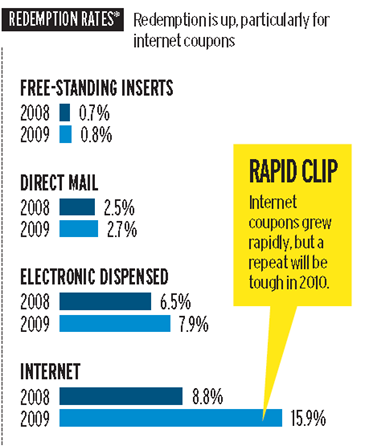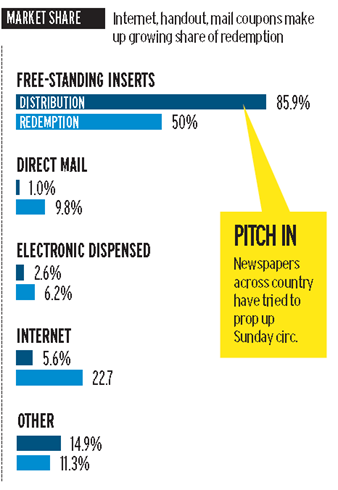The primary use of Coupons, delivered through various mediums, for the CPG manufacturers is to facilitates sales (purchase behavior)through one of the following means:
- Trials.
- Repeat Purchases.
It is an established fact that Advertising Communications and Promotions (AC&P) play an integral role in stimulating sales across the consumer packaged goods industry. Depending on the product / industry lifecycle a brand manager can employ different tactics (Appendix) that are geared towards one of the following:
- Increase Sales on account of Trials by New Users
- Increase Sales on account of Trials / Repurchases by Other Brand Loyal’s
- Increase Sales on account of Trials / Repurchases by Favorable Brand Switchers
- Increase Sales on account of Trials by Other Brand Switchers
- Increase or Maintain Sales on account of Repurchases / Stock-Up by Brand-Loyal’s
For the end buyer, Coupons help realize one of the following objectives:
- An economic motivation – where the main goal is to save money
- A hedonistic motivation – where the aim is to derive pleasure associated with striking a great bargain.
- A routine-loyal, or risk-avoiding motivation – where the goal is to reduce the risk associated with trying a new brand or product.
- A functional one – where the aim is to reduce search costs.
|
Buyer
Group |
Intrinsic Motivation |
Situational Motivation |
Strategy | Tactics |
| Brand Loyal’s | High | Low | Increase Consumption |
Advertising suggesting additional or alternate applications of product |
| Favorable Brand Switchers |
Medium | High | Build Loyalty | Advertising to enhance image. Price Discounts |
| Routine Brand Buyers |
Low | Highest | Attract buyers keep search costs high. |
Price Discounts |
| Other Brand Loyal’s |
High | Low | Entice Brand Switching Minimize Risk |
Comparative Advertising Price Discounts |
| New Category Users |
Lowest | Lowest | Initiate Trials |
Advertising – Create Awareness, Link Brand with Category need. Price Discounts |
Table-1 : Promotion Strategies and Tactics based on Buyer Groups
Challenges facing Brand Managers:
- As newspaper circulation continues to drop across America, Marketers need to adopt new vehicles to push Coupons onto consumers. The available options include Direct-Marketing, Internet based Coupons or Mobile Coupons.
- The current means of distributing coupons are not driving incremental sales. They are more likely to offer discounts to those already planning to buy, thereby cutting at the margins for manufacturers and retailers.
- Coupon usage history cannot be traced down to the individual level. The best available data is geo-demographic level. This lack of transparency hampers price discrimination and identifying well qualified prospects.
Coupon Usage – An Emerging Market perspective
My observations from studying how Advertising Communications and Promotion work in emerging markets (India) highlight two important deviations:
- Coupon distribution is still very much unheard of. Coupon fraud and absence of an organized retail infrastructure have prevented Coupon based marketing promotion from taking off.
- A second reason, an important one, arises from the industry lifecycle. A high growth market such as India offers, CPG manufacturers, brands and market segments that are yet to be established and defined. Consequently the use of Advertising to both position a brand and stimulate sales works very well at this stage in the market.
- The closest thing to using Coupons is the BOGO offers or Bundling that offer manufacturers an option in attracting buyers.
State of the US Coupon Industry – 2010
Through the first nine months of 2010, coupon redemption is up another 5.3% to 2.5 billion vs. the year-ago period, with the value of coupons redeemed up 7.7% to $2.8 billion according to NCH Marketing Services, a unit of Valassis Communications.
Internet coupons still account for only 1% of distribution. The majority of overall growth
in redemptions still come from Free-Standing Print Inserts (FSI), which accounted
for more than 2.1 billion redemptions overall last year, according to NCH data.
According to a recent survey by mBlox almost 70% of coupon users chose Mail/Post and Email as the preferred vehicle for receiving coupons.
Source: mBlox survey conducted by OnePoll, Oct 5-2010
A follow on post will explore who technology can be utilized to alleviate and successfully administer coupon usage to build brand loyalty. How can social networking sites and local deal site come to add value. What do both consumers, retailers, CPG manufacturers and interested stakeholders wish for.
Source:
- NCH Marketing Services, a unit of Valassis Communications i
- Advertising Age
- eMarketer
Appendix:
Impact of Advertising Communications and Promotions in affecting Sales based on product / industry lifecycle.
| Impact on Sales | ||
| Stage in Product / Industry Lifecycle |
Advertisements | Promotions |
| # Introductory Phase | High | High |
| # Growth Phase
1. Differentiated Product / Leader 2. Me-Too Product |
High Low |
Low High |
| # Maturity Phase
1. High Brand Loyalty 2. Low Brand Loyalty |
High
Low |
Low
High |
| # Decline Phase | None | Low |





